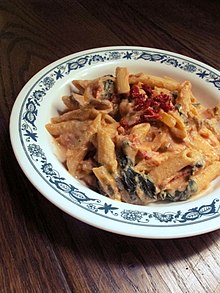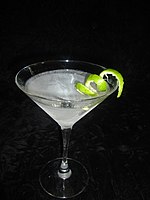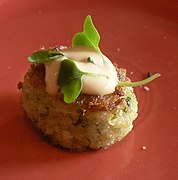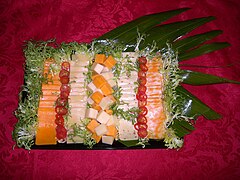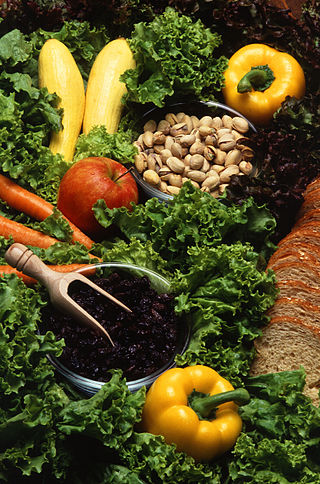
Vegetarian cuisine is based on food that meets vegetarian standards by not including meat and animal tissue products.

An enchilada is a Mexican dish consisting of a corn tortilla rolled around a filling and covered with a savory sauce. Enchiladas can be filled with various ingredients, including meats, cheese, beans, potatoes, vegetables, or combinations. Enchilada sauces include chili-based sauces, such as salsa roja, various moles, tomatillo-based sauces, such as salsa verde, or cheese-based sauces, such as chile con queso.

In cuisine, an omelette is a dish made from eggs, fried with butter or oil in a frying pan. It is quite common for the omelette to be folded around fillings such as chives, vegetables, mushrooms, meat, cheese, onions or some combination of the above. Whole eggs or egg whites are often beaten with a small amount of milk, cream, or water.

Fried rice is a dish of cooked rice that has been stir-fried in a wok or a frying pan and is usually mixed with other ingredients such as eggs, vegetables, seafood, or meat. It is often eaten by itself or as an accompaniment to another dish. Fried rice is a popular component of East Asian, Southeast Asian and certain South Asian cuisines, as well as a staple national dish of Indonesia. As a homemade dish, fried rice is typically made with ingredients left over from other dishes, leading to countless variations. Fried rice first developed during the Sui Dynasty in China.

A fritter is a portion of meat, seafood, fruit, vegetables, or other ingredients which have been battered or breaded, or just a portion of dough without further ingredients, that is deep-fried. Fritters are prepared in both sweet and savory varieties.

Czech cuisine has both influenced and been influenced by the cuisines of surrounding countries and nations. Many of the cakes and pastries that are popular in Central Europe originated within the Czech lands. Contemporary Czech cuisine is more meat-based than in previous periods; the current abundance of farmable meat has enriched its presence in regional cuisine. Traditionally, meat has been reserved for once-weekly consumption, typically on weekends.

Noodle soup refers to a variety of soups with noodles and other ingredients served in a light broth. Noodle soup is a common dish across East Asia, Southeast Asia and the Himalayan states of South Asia. Various types of noodles are used, such as rice noodles, wheat noodles and egg noodles.

Fried onions are slices of onions that are either pan fried (sautéed) or deep fried — and consumed as a popular snack food, garnish, or vegetable accompaniment to various recipes.

Cocktail garnishes are decorative ornaments that add character or style to a mixed drink, most notably to cocktails.

Tunisian cuisine, the cuisine of Tunisia, consists of the cooking traditions, ingredients, recipes and techniques developed in Tunisia since antiquity. It is mainly a blend of Mediterranean and native Punics-Berber cuisine. Historically, Tunisian cuisine witnessed influence and exchanges with many cultures and nations like Italians, Andalusians, French and Arabs.

Squid is eaten in many cuisines; in English, the culinary name calamari is often used for squid dishes. There are many ways to prepare and cook squid. Fried squid is common in the Mediterranean. In New Zealand, Australia, the United States, Canada, and South Africa, it is sold in fish and chip shops, and steakhouses. In Britain, it can be found in Mediterranean 'calamari' or Asian 'salt and pepper fried squid' forms in various establishments, often served as a bar snack, street food, or starter.

Seon is a traditional Korean dish made from steamed vegetables such as zucchini, cucumber, eggplant or Napa cabbage and stuffed with meat. Although the term is a counterpart of jjim — a category of dishes that are made by steaming meat or seafood — the concept is not clearly settled.

Burmese salads are a diverse category of indigenous salads in Burmese cuisine. Burmese salads are made of cooked and raw ingredients that are mixed by hand to combine and balance a wide-ranging array of flavors and textures. Burmese salads are eaten as standalone snacks, as side dishes paired with Burmese curries, and as entrees. The iconic laphet thoke is traditionally eaten as a palate cleanser at the end of a meal.

Indonesian noodles are a significant aspect of Indonesian cuisine which is itself very diverse. Indonesian cuisine recognizes many types of noodles, with each region of the country often developing its own distinct recipes.
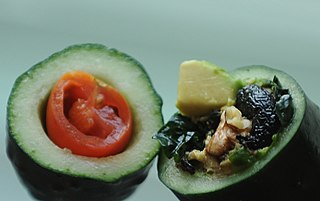
The stuffed cucumber is an ingredient found in various cuisines around the world. Some stuffed cucumber dishes, such as Korean oi sobaegi, incorporate preserved cucumbers, whereas others, such as American recipes, use fresh cucumbers. The ingredients used to actually stuff the cucumber vary widely from cuisine to cuisine.

